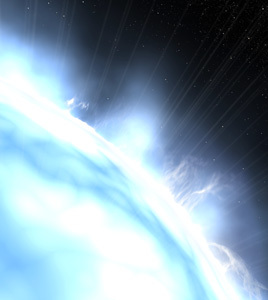
|
| ©Lunarismaar |
| New class of star: An artist's impression of a carbon-rich white dwarf. Most light emitted by these hot stars is in the ultraviolet and blue part of the electromagnetic spectrum. |
According to a report by a private news channel, astronomers have said that this unique stripped-down white dwarf was predicted to exist somewhere in the cosmos, but was found only because of extensive sky surveys.
"They're extremely rare," said astronomer Dr Kurtis Williams of the University of Texas at Austin's McDonald Observatory, where the discovery was made. "It's a real needle in a haystack to find one," he added.
The newly discovered white dwarf star has light wavering by almost 2% every 8 minutes.
Like other white dwarfs, this new star is the remnant of a star, which, in its youth, was probably a bright shining star no more than nine times the mass of the sun. In other words, it was neither exceptionally large nor small as stars go.
Today, what remains is a glowing sphere smaller than earth, with a mass equal to our sun but just one-six hundredth as bright.
Unlike other white dwarfs, however, this one has been stripped of its outer layers of hydrogen and helium and is left with carbon on its surface.
That carbon appears to be at a very toasty 19,500 C, which allows its carbon to shift en masse between a higher and a lower energy state, driven by just one electron per atom. That shifting carbon is visible as the star pulsating.
"Other white dwarfs have been found pulsating, but they are doing it with hydrogen and helium, not carbon," said Williams.
"Of 20,000 known white dwarfs, there were only 10 candidates," said Williams, describing his team's hunt for hot carbon white dwarfs. "Of those, only the one in Ursa Major proved to be pulsating," he added.
As to how this and other carbon white dwarfs became so stripped down, Williams said that one possibility it that the star was very close to the mass at which stars blow up as supernova at the end of their lives instead of becoming white dwarfs.
So its corpse is, likewise, a borderline, strange dwarf.
"Luckily, the pulsations themselves may contain clues to the mystery in the form of seismic information from the interior of the white dwarf," said astronomer Dr Michael Briley of the US National Science Foundation.
"This will allow us to probe the white dwarf's interior, which in turn should help us solve the riddle of where the carbon white dwarfs come from and what happens to their hydrogen and helium," he added.



Reader Comments
to our Newsletter